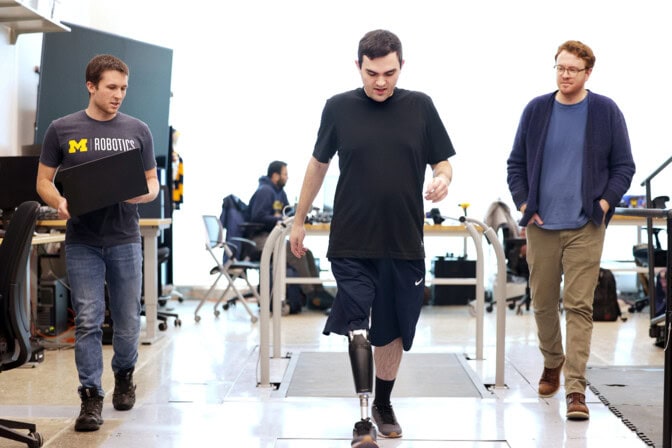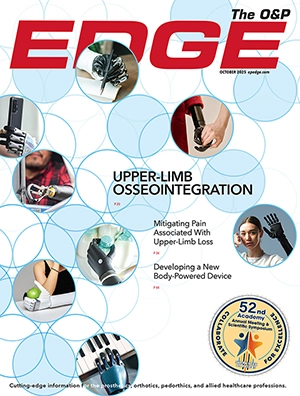Roboticists and prosthetists from the University of Michigan paired custom control software with Össur’s Power Knee to explore expanding the benefits of a commercial robotic prosthetic leg with advanced control. The researchers compared the effects of the powered prostheses with the passive devices the participants usually used.

While the lightness and simplicity of passive legs can be preferred by prosthesis users, for particularly taxing activities like rising from a chair, climbing stairs and hills, and walking long distances, the addition of power has the potential to help them be more active while also preventing overuse injuries.
The team investigated two fundamentally different control approaches. Össur’s more conventional controller relies on recognizing specific features of the user’s motion, indicating what they’re about to do. This makes the system very safe and predictable but may not always keep up with the user’s intent, said Robert Gregg, PhD, a professor of robotics and corresponding author of the study. In order to sit, users have to wait for the knee to recognize the sitting motion before it will bend, and likewise with standing.
In contrast, the control approach developed by Gregg’s team continually adjusts to the user’s motion. They built mathematical models of how humans move, based on large datasets of unimpaired individuals. At each moment in time, their control algorithm measures the user’s thigh motion to determine the right behavior, creating more natural knee motions that are better synchronized with the user.
The researchers focused on key activities of daily living in which a powered prosthesis could provide meaningful benefits compared to passive knee prostheses. Study participants repeatedly sat and stood; walked quickly on a treadmill; and repeatedly sat in a chair, walked, and sat down again.
The participants who required extra walking assistance, such as a cane, found that the Power Knee offered significant help in all these tasks. Those who get around more easily with their passive prostheses saw the most improvement in their gaits when Gregg’s team implemented their own control algorithm on Össur’s leg.
“Our goal in prosthesis control is to make the leg behave as close as possible to the missing human limb in order to prevent compensations that often lead to overuse injuries. It also matters because gait deviations can bring unwanted attention to some users,” said Kevin Best, PhD, a research associate in robotics and first author of the study.
The new control algorithm is harder to learn after using a conventional prosthesis for years, but the repeated sit-to-stand trials showed that participants were learning. Rather than getting more tired with each trial, they got faster. Then while walking, the more mobile group showed two improvements that could become significant benefits: They lifted the toe of the prosthetic foot higher, reducing the risk of tripping over small obstacles or rougher terrain, and they didn’t need to swing their hips as hard to move the prosthetic leg forward, hinting that the powered knee and lifelike control algorithm could potentially reduce back pain and allow users to go farther before getting tired.
“Our study is significant because evidence was previously lacking for benefits of robotic knees over advanced passive knees, which is a big reason insurance companies don’t typically cover robotic knees. Our results begin to provide this evidence,” said Gregg.
Next, the team hopes to demonstrate the safety and effectiveness of their control algorithm with stairs and ramps, followed by take-home tests.
“With the improvements in robotic devices, it is clear that robotic prostheses offer great promise to the amputee population,” said study co-author Jeff Wensman, CPO, Michigan Medicine. “I am excited to see the advancement of a strategy to provide powered prosthesis users with user-synchronized control. I believe that this is a missing link to making powered prosthetics a reality for amputees.”
Editor’s note: This story was adapted from materials provided by the University of Michigan.
To see videos of the control system in use, visit “Using an Advanced Control Algorithm to Improve Powered Knee Performance” on the Michigan Engineering YouTube channel here and here.
To read more, visit “Study Compares Clinical Effects of Powered Knee Prostheses” on The O&P EDGE website.



